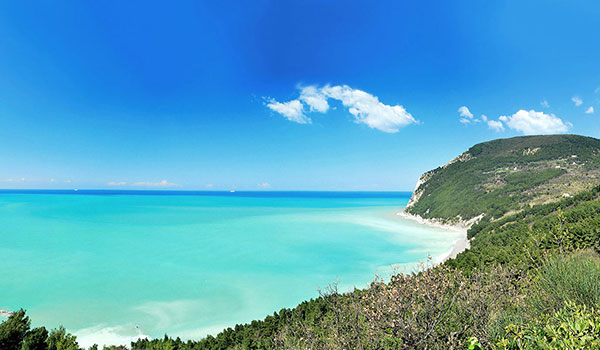
The Marches, it is said, is a ‘plural’ region. From time to time the ‘march’ of Ancona, or of Camerino or Fermo may be spoken of, recognising that each of these has its own specific character and structure. This multiplicity is today seen as a valuable quality that can offer a great deal on a cultural level, as well as the advantages of varied landscape and tradition. Secured by travel in Italy, the region of the Marches has always been a land to pass through, and, since the very beginning, an identification has been made between landscape and countryside, and nature and faming civilisation, the first being extremely organised and subdued, the second humble and almost primitive. Even in literature dating back to Mediaeval Times, the region underwent a first distinction of territorial fascias: Montefeltro and Sibillini were recognised as ‘wild’, the hills and valleys as fertile, and the coast as being sunny. Rather than from North to South, the Marches walk par excellence is identified as being a route that goes from the Mountains to the Sea. The difficulty of the Apennine passes and the ancient activities linked to stock rearing, make the Mountain band a place that is certainly not a fringe area. It was, however, a hard life for populations who were diffident of foreigners, taking refuge in strategic heights, equipped with towers and castles in impossible positions and who used sheep and dairy products, a little wheat and many vegetables and chestnuts to survive. A harsh scene, which extends towards the East, becoming hills and valleys rich with wheat fields, vines and olive groves, orchards and vegetable cultivations, where life is sweeter. Here the houses open onto courtyards and gardens, and the churches reveal elegant architecture. It is, however, from the East that news arrives: after the Saracen incursions, the sea is once again seen as a means of communication that makes trade and commerce easier. For a long time the coast was almost deserted, and nothing more than a blue, mobile, backdrop. Only the toughest sailors and most hardened fishermen ventured out onto the sea. The sea which has since brought the most important productive activities to the valley, not to mention the summer tourist invasion. The expanses of fine sand remain, with water that is finally clear, and rocky and green coastal headlands.


